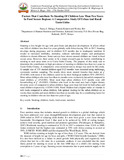Factors That Contribute To Stunting Of Children Less Than Two Years In Food Secure Regions: A Comparative Study Of Urban And Rural Uasin Gishu
Abstract
Stunting is low height for age with poor brain and physical development. It affects about
one fifth of children less than five years globally with Africa having 39% in 2017. Stunting
develops during pregnancy and in children 0-23 months due to inadequate nutrition. It
results to increased morbidity, mortality, reduced individual output, and predisposes
children to chronic illnesses. Some surveys have shown stunted children are found in food
secure areas. However, there seems to be a major research gap on factors contributing to
stunting in such areas more so in Uasin Gishu County. The purpose of this study was to
determine the contributors to high prevalence of stunting in children less than two years in
Uasin Gishu County. A comparative cross-sectional survey design was used for this study.
A sample size of 331 stunted children aged 0-23 months were recruited using multistage,
systematic random sampling. The results show more stunted females than males at χ2
(P=0.001) with most of the children cared for by their biological mothers 92% (305/331).
More urban children who were less than six months were exclusively breastfed compared to
rural children, χ2 (P=0.001). More rural than urban children 6-23 months were still
breastfeeding at χ2 (P=0.001). Children who lived in the rural area had a higher dietary
diversity score ≥4 compared to urban children. Eggs were least fed food for both urban and
rural children respectively (13/269:11/88). Rural children had a higher intake of vitamin A
rich foods compared to urban children. Sub optimal feeding for the urban children six to
twenty three months and rural children less than six months may be a contributing factor for
stunting in children who are less than two years of age.

